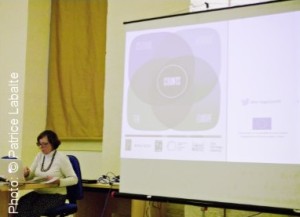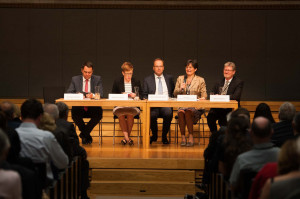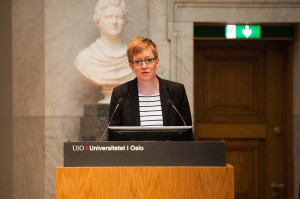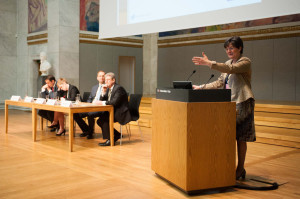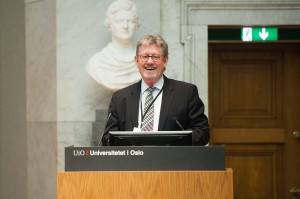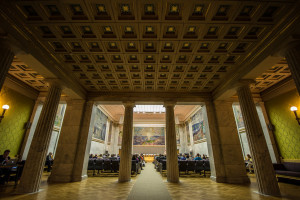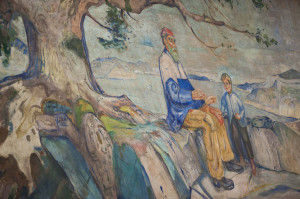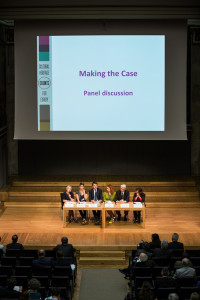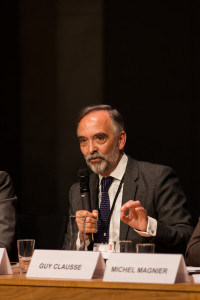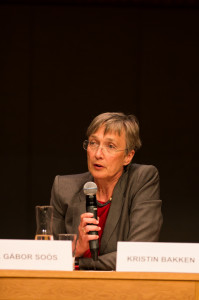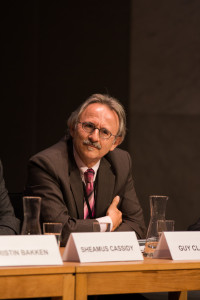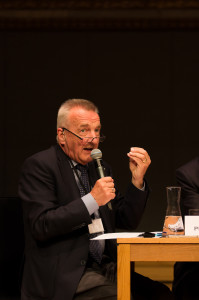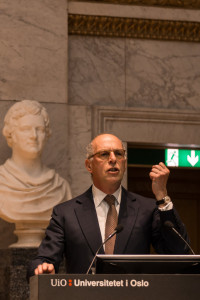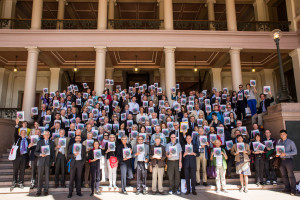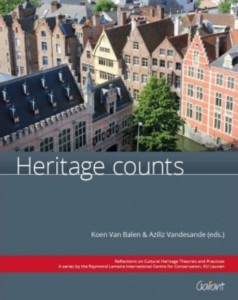 In February 2015, the Cultural Heritage Counts for Europe Consoritum organised a panel discussion in the framework of the international conference “Heritage Counts” on the economic, social, environmental and cultural impact of built cultural heritage. Held from 3-5 February 2015 the event was organised by CHCFE partner, the Raymond Lemaire International Centre for Conservation (KU Leuven) in Leuven, Belgium.
In February 2015, the Cultural Heritage Counts for Europe Consoritum organised a panel discussion in the framework of the international conference “Heritage Counts” on the economic, social, environmental and cultural impact of built cultural heritage. Held from 3-5 February 2015 the event was organised by CHCFE partner, the Raymond Lemaire International Centre for Conservation (KU Leuven) in Leuven, Belgium.
The Heritage Counts conference was a very successful 2nd edition of the yearly Thematic Week, thanks to the enthusiastic discussions among international and interdisciplinary participants as well as the link with the Cultural Heritage Counts for Europe project, funded by the EU Culture Programme (2007-2013) and the support of Europa Nostra, the lead partner of the consortium of 6 organisations.
Taking into account the many fruitful discussions and positive messages on the relevance of this topic, a rigorous publication that encompasses the conference’s content and quality was developed. After an extensive editing process, the “Heritage Counts” publication with Guaranteed Peer Reviewed Content (GPRC) is in print at this very moment!
Koen Van Balen and Aziliz Vandesande (Eds.), “Heritage Counts”, Reflections on Cultural Heritage Theories and Practices. A series by the Raymond Lemaire International Centre for Conservation, KU Leuven, vol. 2, Garant: Antwerp – Apeldoorn, 2015.
ISBN 978-90-441-3330-1 | 320 pp.
Full color, illustrated | 20×25 cm
The publishing company offers a discount pre-subscription offer until 15th December 2015!
€ 39 | VAT & shipment included
As from 15th December € 49 | VAT included, shipment € 5
Please find the complete table of contents and the pre-subscription form.
On 22 October in Lecce, Italy the CHCFE project was presented during the 23rd ENCATC Annual Conference “The Ecology of Culture”. During the “Creative Heritage” Seminar, Claire Giraud-Labalte, CHCFE Steering Committee Member and Chair of the ENCATC Thematic Area “Understanding Heritage” lead this gathering that focused on the managment of an archaeology site and best practice examples of co-creation and community engagement in the preservation and valorization of Cultural Heritage.
The occasion was a perfect setting to present the project and its main findings to this audience of 26 academics, researchers and heritage professionals from Belgium, Canada, China, Finland, France, Italy, Lithuania, Netherlands, Serbia, and the United States. The project results presentation complimented seminar’s aims to: present and promote local practices relating to the conceptual framework of the Annual Conference theme on the ecology of culture; experience cross-fertilization with experts from different disciplinary backgrounds, take into account current events in the field of cultural heritage and museums; and promote the exchange of knowledge and networking for future join-projects.
Claire Giraud-Labalte also gave a presentation on “What’s new for Cultural Heritage?” For the seminar’s many international participants, she provided a brief history of European cultural heritage policy and the latest major EU developments impacting cultural heritage. This presentation also provided examples of new perspectives for cultural heritage from the Council of Europe, the Namur Declaration, and the European Cultural Heritage Year 2018.
The seminar also included two study visits, first to the archaeology Rudiae site in Salento with a guided tour by Francesco D’Andria, Professor Emeritus, University of Salento, Italy and Grazia Semeraro, Professor, University of Salento, Italy. This was followed by a visit of the Diffused Museum of Cavallino with a tour given by Grazia Semeraro, the Museum’s Director.
Seminar Material
Presentation by Claire Giraud-Labalte | Download here.
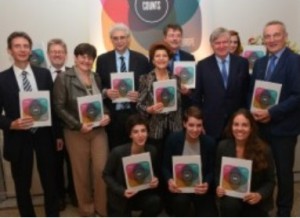
From Left to Right standing: Walter Zampieri, Brian Smith, Sneska Quaedvlieg-Mihailovic, Prof. Jacek Purchla, Former Commissioner Androulla Vassiliou, Prof. Koen Van Baelen, Denis de Kergorlay, Irene Braam, Piet Jaspaert
From Left to Right kneeling: Danae Anastopoulos-Chaimowicz, Aziliz Vandesande, Louise van Rijckevorsel
Photo: Detlef Grosse
Keeping the momentum for cultural heritage that has been so visible in Europe for the past two years with the adoption of major policy documents by all EU institutions, and most recently by the European Parliament with the adoption on 8 September of the Resolution of the European Parliament “Towards an integrated approach to cultural heritage for Europe”, members of the Cultural Heritage Counts for Europe consortium organised a special networking event to officially present the CHCFE final publication in Brussels. Led by the CHCFE project leader, Europa Nostra and its corporate partner Bertelsmann, the event was held on the evening of 22 September 2015 at the Bertelsmann’s Brussels Office.
The event was attended by former European Commissioner for Education, Culture, Multilingualism and Youth, Androulla Vassiliou, as special guest, as well as by officials of various European Commission Directorate Generals, representatives of the Permanent Representations of EU Member States and Members of the European Heritage Alliance. The directors of the two research partners, Professor Jacek Purchla of the International Cultural Centre in Krakow and Professor Koen Van Baelen of the Raymond Lemaire Centre for Conservation, briefly presented the Full Report ‘Cultural Heritage Counts for Europe’. The Report is the result of a two-year project supported by the Culture Programme of the European Union which provides compelling evidence of the impact of cultural heritage on the economy, society, culture and the environment.
In their presentation, they highlighted some key findings which are particularly relevant for EU policy circles: first, that cultural heritage represents a great potential for return in investment in fields as varied as employment and job creation, regional attractiveness, quality of life, climate change, education, lifelong learning and social cohesion; second, that cultural heritage can become a major driver of sustainable development when policies and investments related to all these fields are well coordinated; and third, that until now this full potential still remains largely untapped.
Following the presentations, former European Commissioner, Androulla Vassiliou, warmly thanked the researchers for producing such an important document, which provides relevant, factual information necessary to substantiate heritage policies across policy fields, thereby contributing to the implementation of a truly integrated approach to cultural heritage at all levels of governance.
Irene Braam, Senior Vice-President Government Relations and Head of the Bertelsmann Brussels Liaison Office, was delighted to host this event. “Bertelsmann is very proud to be the corporate partner of Europa Nostra. We also congratulate the authors of the important book “Cultural Heritage Counts for Europe” to the printing of which Bertelsmann was glad to contribute”.
The holding of this event was particularly timely, one week prior to the debate organised by the Italian and Spanish Permanent Representations on the proposal to establish 2018 as the European Year of Cultural Heritage entitled ‘A European Year of Cultural Heritage: sharing heritage, a common challenge’ (on 28 September 2015) and one month before the European Culture Forum was scheduled to be held by the European Commission (which was unfortunately cancelled due for security reasons).
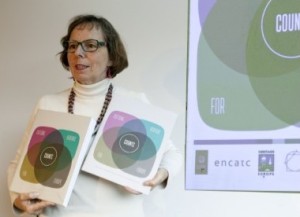
Claire Giraud-Labalte, member of the CHCFE Steering Committee on behalf of ENCATC and chair of the ENCATC Thematic Area Chair of “Understanding Heritage”
The results of the Cultural Heritage Counts for Europe project were presented to the Reflection Group “EU and Cultural Heritage” during their meeting held from 23-25 September in Luxembourg. Reflection group member, Claire Giraud-Labalte, member of the CHCFE Steering Committee, ENCATC Thematic Area Chair of “Understanding Heritage” and ENCATC Ambassador, was invited to present the project’s final publication and key findings along with Piet Jaspaert, Vice-President, Europa Nostra and member of the CHCFE Steering Committee. With an audience of representatives from European institutions, UNESCO, European heritage institutes and monuments and heritage networks, it was crucial to share the project results to ensure key players in policy and heritage have the resource to provide concrete evidence of the impact of cultural heritage on the economy, society, culture and the environment.
This meeting was also the opportunity for participants to discuss the importance to cultural heritage and international relations, as well as the international dimensions inherent to local heritage, be it historical or contemporary. The 3-day programme included expert testimony from UNESCO, the Council of Europe, the European Investment Bank, European heritage and cultural networks, and national governments. Participants were also invited to study visits to discover local heritage and meet with operators in the field.
The Reflection group “EU and cultural heritage” was established during the Belgian Presidency of the Council of the European Union in 2010. Its mission, according to the Declaration of Bruges, is to study the impact on cultural heritage of EU legislation and policies and to ensure ways so that the potential of cultural heritage is better accentuated and disseminated. The Reflection Group on “EU and Cultural Heritage” composed of the representatives of EU Members States and also of European networks active in the field of cultural heritage.
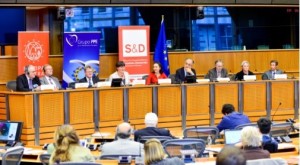
FAVEL Bruno, KOCH Uwe, SMITH Brian, QUAEDVLIEG-MIHAILOVIC Sneska, TAPARDEL, Claudia, MILLAN MON, Francisco Jose (EPP,ES), CLAUSSE Guy, PUGH Kate, ZAMPIERI Walter
Meeting of the intergroup on European tourism development, cultural heritage, Ways of St. James and other European cultural routes
© European Union 2015 – Source : EP
On 16 September in Brussels, the results of the ‘Cultural Heritage Counts for Europe’ (CHCFE) project were presented to the Members of the European Parliament in Brussels during the meeting of the Intergroup on European tourism development, cultural heritage.
Following just a week after the adoption by the European Parliament of a Resolution calling for the implementation of an integrated approach to cultural heritage for Europe (with over 80% of MEPs voting in favour), cultural heritage was at the heart of discussions of this first ever meeting of the European Parliament Intergroup on European tourism development, cultural heritage and the Way of St James and other cultural routes. This meeting gathered over 100 participants from the European Union Institutions, representatives of EU Member States and Regions, European civil society and the private sector. Co-organised by Europa Nostra, leader partner of the Cultural Hertiage Counts for Europe project, and the Co-Chair of the Intergroup, Ana-Claudia Tapardel (S&D, Romania), with the support of the other Co-Chair, Francisco Millan Mon (EPP, Spain), this meeting was dedicated to the presentation of the results of the Cultural Heritage Counts for Europe project. It provided an ideal platform to join forces in support of cultural heritage as a key resource for sustainable development in Europe and also as a vital tool for promoting the much needed inter-cultural dialogue within Europe and also between Europe and the rest of the world.
Silvia Costa, Chair of the EP Committee on Culture and Education, opened the meeting by praising the importance of the Cultural Heritage Counts for Europe report. She recalled the hearing on Intercultural dialogue and education for mutual understanding organised by her Committee the previous day (15/09) with the participation of Irina Bokova, Director General of UNESCO, as a key-note speaker. “We must condemn any act of deliberate destruction of cultural heritage and we must use the power of cultural heritage to foster Europe’s cultural diplomacy and to promote intercultural dialogue in Europe and beyond,” said Silvia Costa.
Speaking on behalf of Europa Nostra, the European Heritage Alliance 3.3 and members of the Cultural Heritage Counts for Europe consortium, Sneska Quaedvlieg-Mihailovic, Europa Nostra’s Secretary General, welcomed the establishment of the EP Intergroup covering cultural heritage as a transversal policy issue and expressed the hope that from now on the dialogue between Europe’s various stakeholders, including civil society and MEPs will become much more regular and more effective. She also referred to the tragic exodus of people coming to Europe in search of safety and hope for a better life. She argued that “host countries and communities should be prepared to learn about and respect the immaterial heritage these hundreds of thousands of people are bringing with them while at the same time finding the proper ways to help the refugees to learn about and respect the culture and heritage of their new living environment”.
The two-hour discussion was rich in examples of how cultural heritage counts for Europe. Speaking on behalf of the CHCFE Consortium, Kate Pugh of the Heritage Alliance presented the results and implications of the ‘Cultural Heritage Counts for Europe’ Report which was produced in June 2015 by a European consortium composed of six partners, using a series of concrete examples which are in the report. She closed her intervention by underlining that Europe should be deploying much more its soft power, including the power of its cultural heritage. Guy Clausse, Dean of the European Investment Bank Institute (EIBI), presented ‘The 7 Most Endangered’ programme run by Europa Nostra in partnership with EIBI and stressed the need for stronger pooling of resources between local, regional, national and European authorities to ensure the necessary funding for saving Europe’s (endangered) heritage. Uwe Koch of the German National Heritage Committee presented the concept note, under preparation by the Reflection Group “EU and Cultural Heritage”, on the proposed European Year of Cultural Heritage in 2018, putting forward the central theme of the Year: “sharing heritage”, which “allows for everyone to discover and to join in on how to share heritage”.
The discussion also gave an audible voice to a series of vital actors in the conception and implementation of any credible policy towards cultural heritage, namely: the Council of Europe, the European Commission and historic towns and regions. In his reaction to the first panel, Bruno Favel, Chair of the Steering Committee for Culture, Heritage and Landscape of the Council of Europe, payed tribute to Khaled al-Asaad, the late archaeologist looking after the site of Palmyra for 40 years and who was killed by Islamic State (IS) militants this August, and made a strong plea to perceive and use cultural heritage as a vehicle for intercultural dialogue and respect. Walter Zampieri, Head of Unit in the DG for Education and Culture of the European Commission, presented the active role of the European Commission in this field over the past few years and thanked the European Parliament and the European civil society, especially Europa Nostra and the European Heritage Alliance 3.3, for a constructive partnership. Brian Smith, Secretary General of the European Association of Historic Towns and Regions, called for the need to shift the momentum from the European level to the national, regional and local levels – in particular historic towns and regions. He also welcomed the possibility of having a cultural heritage year in 2018 to provide “real focus for action and change”.
Closing the meeting, the President of the European Socialists and Democrats, Gianni Pittella, congratulated the Consortium for the ‘Cultural Heritage Counts for Europe’ Report and underlined the importance of recognising the immense added value of cultural heritage, stating that “Europe as we know it today is the result of a long history where the values of diversity, tolerance and multiculturalism have always played an important role. Our cultural heritage is the best testimony ever of the very rich history of the European continent”.
Speeches and Presentations
Speech by Brian Smith, CHCFE Steering Committee Member | Download here.
Speech by Kate Pugh, CHCFE Steering Committee Member | Download here.
Presentation by Kate Pugh, CHCFE Steering Committee Member | Download here.
Background Information
European Parliament Intergroups are informal groupings of MEPs from different countries and different political parties gathering to discuss transversal policy issues for which they share an interest and which they wish to promote. Such Intergroups also provide a suitable platform for MEPs to engage in a regular dialogue with various stakeholders, including civil society and the private sector.
For more information related to Intergroups, click here.
For the composition of the EP Intergroup on European tourism development, cultural heritage and the Way of St James and other cultural routes click here.
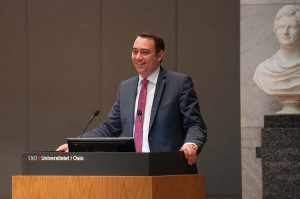
Maxime Prévot, Vice-President and Minister of Wallonia’s Government, Chairman of the 6th Council of Europe Ministerial Conference for Heritage
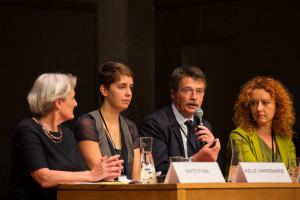
Panel I. Making the Case with Kate Pugh, CEO, The Heritage Alliance (England, UK); Aziliz Vandesande, Phd Researcher, Raymond Lemaire International Centre for Conservation, University of Leuven (Belgium); Prof. Koenraad Van Balen, Director of the Raymond Lemaire International Centre for Conservation, University of Leuven (Belgium); and Joanna Sanetra-Szeliga, Researcher at the Institute for European Heritage, International Cultural Centre in Krakow (Poland)
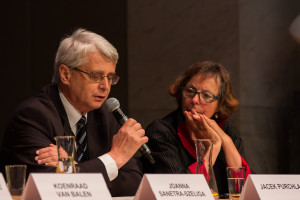
Panel I. Making the Case with Prof. Jacek Purchla, Director of the International Cultural Centre in Krakow (Poland) and Prof. Claire Giraud-Labalte, Chair of the ENCATC Thematic Area Understanding Heritage and ENCATC Ambassador, Nantes (France)
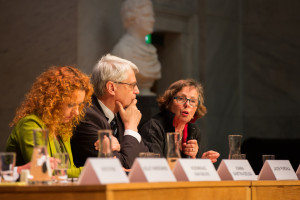
Panel I. Making the Case with Joanna Sanetra-Szeliga, Research Institute for European Heritage, International Cultural Centre in Krakow (Poland); Prof. Jacek Purchla, Director of the International Cultural Centre in Krakow (Poland); and Prof. Claire Giraud-Labalte, Chair of the ENCATC Thematic Area Understanding Heritage and ENCATC Ambassador, Nantes (France)
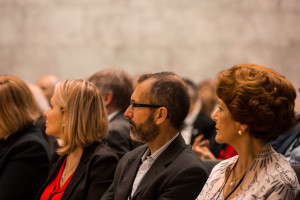
Androulla Vassiliou, former European Commissioner for Education, Culture, Multilingualism and Youth (right), Michel Magnier, Director for Culture and Creativity, Directorate General for Education and Culture, European Commission (centre), Adrienn Kiraly, Deputy Head of Cabinet of Commissioner Navracsics (left)
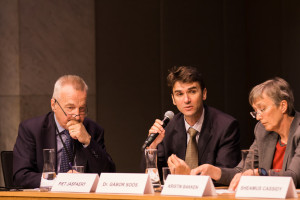
Panel II. with Piet Jaspaert, Board Member, Europa Nostra; Gábor Soós, Head of Division, Division of World Heritage, Gyula Forster National Centre for Cultural Heritage Management, Budapest (Hungary); and Dr. Art. Kristin Bakken, Deputy Director, Directorate for Cultural Heritage in Norway
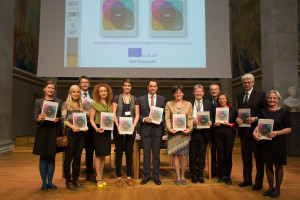
Members of the CHCFE consortium with Maxime Prévot, Vice-President and Minister of Wallonia’s Government, Chairman of the 6th Council of Europe Ministerial Conference for Heritage
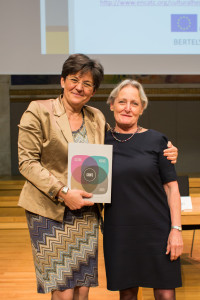
Sneška Quaedvlieg-Mihailović, Secretary General of Europa Nostra and Kate Pugh, CEO, The Heritage Alliance (England, UK)
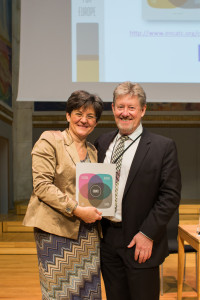
Sneška Quaedvlieg-Mihailović, Secretary General of Europa Nostra and Brian Smith, Secretary General of Heritage Europe
All photos by Felix Quaedvlieg originally published on Flickr / CC BY-NC-SA 2.0
Cultural Heritage Counts for Europe Concluding Conference
12 June 2015 at the University of Oslo in Norway
Address by Tibor Navracsics, European Commissioner for Education, Culture, Youth and Sport to attendees during the opening session.
(Check against delivery)
Ladies and gentlemen,
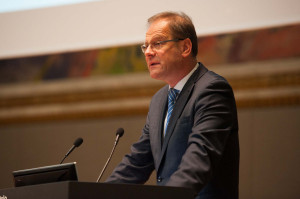
Tibor Navracsics, European Commissioner for Education, Culture, Youth and Sport speaking at the Cultural Heritage Counts for Europe concluding conference in Oslo on 12 June 2015.
Yesterday, at the Oslo City Hall, I took part in the celebration of the European Union Prize for Cultural Heritage/Europa Nostra Award for the first time. It was inspiring. We paid tribute to the many experts and volunteers who safeguard the values embodied in our cultural heritage so that it can be passed on to future generations.
Today, in this magnificent aula, surrounded by Edward Munch’s masterpieces, we will reflect more on those very values. We will look at the benefits that the project “Cultural Heritage Counts for Europe” has identified. Benefits for European culture, the environment, the economy and for society as a whole.
For all of us here, there is no doubt that heritage matters. It is the soul of our cities and the source of our identity. But we all know too well that many people are indifferent to cultural heritage, or simply not aware of its value.
This is a real problem. We are so used to what surrounds us – the historic environment, the archaeological sites – that we may forget that heritage needs a lot of care to survive.
It is sad, but we seem to appreciate its value most when it is under threat. This is the case today, not so far from here. Like you, I am appalled when I see the terrible destruction of heritage in countries like Iraq and Syria. These are unacceptable attacks on the culture of those countries and on the people who live there. But let me be clear: These crimes are also attacks on our shared values as human beings, wherever we happen to live.
Then there are other, less violent threats to heritage. Wherever investment in cultural and heritage policies is reduced, heritage is in danger. Unfortunately, because of the economic crisis, we see this happen a lot. We need swift action – and an evidence-based approach to cultural policy-making.
A wealth of studies highlights the significant contribution of the heritage sector to economic and social development. We know that cultural heritage can boost other economic sectors. Tourism, for instance, is estimated to contribute EUR 415 billion to the EU’s Gross domestic product. 3.4 million tourism enterprises account for 15.2 million jobs – many are linked to heritage, directly or indirectly.
But these are only partial estimates. EU-wide comparable data are still lacking. And in modern policy-making, a lack of data is fatal. As cultural operators know, when it comes to convincing decision makers to invest in culture, even the most compelling data may not be a guarantee of success. However, without any data, you are bound to fail from the start.
This is what makes “Cultural Heritage Counts for Europe” so important. I would like to thank the consortium for helping to fill this gap. Your project provides a much-awaited mapping of the research carried out at the European, national, regional and sectoral levels. You are helping to build the case for heritage in a solid and rigorous manner.
Now we can prove that the regeneration of urban sites attracts investment and creates jobs. Look at what happened at the Zsnolnay Cultural Quarter in Pecs or the Temple Bar in Dublin. And the high returns of investing in heritage are certified by a study by the World Bank.
All available evidence confirms that heritage is a strategic resource for a sustainable Europe. EU Member States clearly and explicitly recognised this last year.
But this is not enough. We need to enhance our policy action at all levels, including the European one.
This was the European Commission’s intention last year, when we published our strategy “Towards an integrated approach to heritage policies”. We proposed a way forward for enriching the value of cultural heritage further. This vision, which owes a lot to my predecessor Androulla Vassiliou’s commitment, has been fully endorsed by the new Commission. It will be our roadmap for the next five years.
New funding opportunities are supporting this approach, with programmes such as Creative Europe, Horizon2020, Erasmus+ and our structural funds.
And with actions like the European Capitals of Culture, the European Heritage Label, the European Heritage Days – and of course the European Heritage Awards – we are stimulating the whole cycle of cultural production and preservation. We are promoting high standards and high-quality skills in conservation practice. We are engaging Europe’s citizens in a deeper reflection on the roots and the meaning of European identity.
The main challenge now is to take advantage of these opportunities. It is time to develop a truly integrated approach to heritage, maximising the impact of heritage policies on the local economy and society. This is one of my priorities.
We have just started work with Member States on improving the governance of heritage policies. Good governance can contribute to a virtuous cycle of economic growth and social progress. But for this, public and private actors, local communities and stakeholders must all be active in managing and maintaining heritage.
We are identifying innovative models for participatory governance for cultural heritage. There is a wealth of good practices across the EU from which we can learn. I am confident that this work will be extremely useful.
Ladies and Gentlemen,
When Edward Munch decorated this aula, he wanted to create an artwork which was both distinctively Norwegian and universally human. The Alma Mater who nurtures her children with knowledge and the old man recounting his memories to a fascinated little boy remind us that it is not enough for the monuments of the past to be standing if their meaning is lost.
The knowledge embodied in those monuments must be preserved as well. It must be transmitted to the next generations. This is a task for every single one of us. Thanks to this project, we are one step closer to achieving it.
Thank you.
This speech was originally published on the European Commission’s website here.

